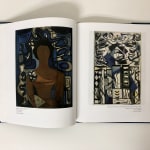-
Artworks









Amelia Peláez / Marta Arjona
Ceramic tiles based on an Amelia Peláez' tempera on paper, 1999Ceramic tiles mural realized by Marta Arjona and René Valenzuela, based on the original 1956 tempera on paper by Amelia Peláez for a mural not realized.84 x 60 x 4 in
213.4 x 152.4 x 10.2 cm535-2970Further images
-
(View a larger image of thumbnail 1
)

-
(View a larger image of thumbnail 2
)

-
(View a larger image of thumbnail 3
)

-
(View a larger image of thumbnail 4
)

-
(View a larger image of thumbnail 5
)

-
(View a larger image of thumbnail 6
)

-
(View a larger image of thumbnail 7
)

-
(View a larger image of thumbnail 8
)

-
(View a larger image of thumbnail 9
)

Amelia Peláez was born in 1896 in Yaguajay, in the former Cuban province of Las Villas (now Sancti Spíritus Province). In 1915, her family moved to Havana, to the La...Amelia Peláez was born in 1896 in Yaguajay, in the former Cuban province of Las Villas (now Sancti Spíritus Province). In 1915, her family moved to Havana, to the La Víbora district, and this gave her the opportunity to enter the Escuela Nacional de Bellas Artes "San Alejandro" at the rather late age of 20 years (students at this academy usually start at 12-13 years of age). She was among Leopoldo Romañach's favourite students. In 1924 she graduated from San Alejandro, and exhibited her paintings for the first time, along with another Cuban female painter, María Pepa Lamarque, at the Association of Painters and Sculptors in Havana. Receiving a small government grant, she travelled to New York City in the Summer of 1924 and began six months of study at the Art Students' League. In 1927, after being awarded a larger grant, she began studying in France, while paying short visits to Spain, Italy, and other countries. In Paris, she took drawing and art history courses at the Académie de la Grande Chaumière, the École Nationale Supérieure des Beaux-Arts, and the École du Louvre. In 1931 she began studying with Russian painter Alexandra Exter, whose classes in color theory and design were an important influence.Galerie Zak hosted an exhibition of her paintings in 1933, and the following year she returned to Cuba. Peláez received a prize in the National Exposition of Painters and Sculptors in 1938, and collaborated on several art magazines in Cuba, such as Orígenes, Nadie Parecía, and Espuela de Plata. In 1950 she opened a workshop at San Antonio de los Baños, a small city near Havana, where she dedicated herself, until 1962, to her favourite pastime of pottery. She sent her paintings to the São Paulo Art Biennial in 1951 and 1957, and participated in 1952's Venice Biennale. In 1958 she was a guest of honour and jury member at the First Inter-American Biennial of Painting and Printmaking in Mexico City, although she pulled out of the raucous and controversial jury discussions based on what she reported to be "an openly Communist bias in the decisions." Aside from painting and pottery, she dedicated time to murals, located mainly at different schools in Cuba. Her most important works of this type are a ceramic mural at the Tribunal de Cuentas in Havana (1953) and the facade of the Habana Hilton hotel (1957). The works of Peláez are held in the Museo Nacional de Bellas Artes de La Habana and the Museum of Modern Art, New York. Peláez died in Havana in 1968.Provenance
Marta Arjona
Sold in Bonhams Auction, February 2025 for $20,000.00
Exhibitions
The Lost Generation: Women Ceramists and the Cuban Avant-Gare. Daley Family and Monan Galleries (January 29-June 2, 2024). Organized by the McMullen Museum. Curated by Elizabeth Thompson Goizueta and underwritten by Boston College, with support from the Patrons and the Hispanic Art Initiative of the McMullen Museum.Literature
Catalogue from The Lost Generation: Women Ceramists and the Cuban Avant-Gare. Daley Family and Monan Galleries (January 29-June 2, 2024). Organized by the McMullen Museum. Curated by Elizabeth Thompson Goizueta. ISBN: 978-1-892850-44-7. Distributed by the University of Chicago Press. Printed in the USA. 2023 The Trustees of Boston College.
(Back and endpapers)
Publications
Catalogo del Museo Nacional de La Habana Exhibicion, Amelia Pelaez Oleos, temperas y dibujos 1924-1967, Centro Wilfredo Lam Agosto 2 - Septiembre 15 de 1996, Pg. 5520of 20 -
(View a larger image of thumbnail 1
)
Please enter your details
Checking your information









